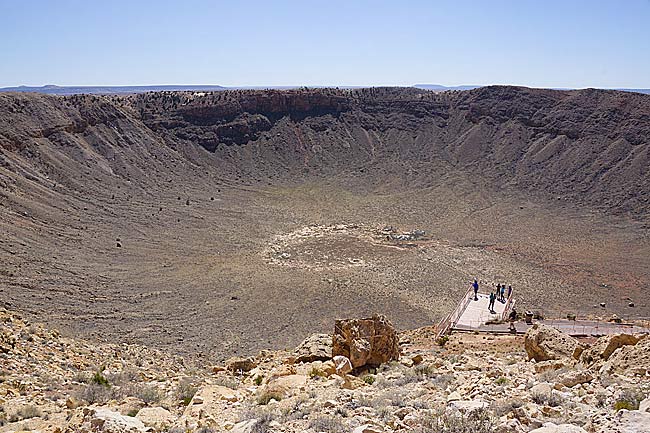Meteor Crater Near Winslow Arizona A Reminder Of Asteroid Impact Dangers

Meteor Crater: Winslow, Arizona
Wow, just wow…
We recently visited the meteor crater near Winslow, Arizona (for the purpose of this post!) and it was an awesome visual reminder of the devastating potential from asteroids (becoming meteors when they enter our atmosphere) smashing into our planet.
50,000 years ago, a pinpoint of light grew rapidly into a brilliant meteor.
The hunk of iron-nickel probably broke free from the asteroid belt during a collision among the countless asteroids circling there.
It only took seconds to pass through our atmosphere at an estimated speed of 26,000 miles per hour and in a blinding flash the mass of several thousand tons of rock (estimated to be 150 feet across) smashed into earth with an explosive force greater than 20 million tons of TNT.
175 million tons of limestone and sandstone were blasted out of the crater. A dense hot cloud quickly rose high above the crater and rained down as fallout across the land.
And all this was caused by a meteor that was “just” 150 feet across.
Related: Stunning Simulation Video Of Asteroid Belt
While sitting on a bench at the crater rim, I contemplated the massive hole in front of me with respect to the size of the meteor itself. I imagined the massive ejecta thrown out and I imagined how much terribly worse it would be for a meteor even larger.
If a 150 foot asteroid blasted a 4,000 foot wide by 700 foot deep crater (with all that earth being ejected into the sky), how big would a crater be (and ejecta) from a 1,000 foot wide meteor? Answer: You don’t want to know!
What’s interesting is how many times that a new asteroid is discovered hurling into our proximity – sometimes only days away from zipping past the earth at tens of thousands of mph. They seemingly come out of nowhere.
According to The Armagh Observatory (a modern astronomical research institute and the oldest scientific institution in Northern Ireland) it is estimated that there may be between 100,000 to 1,000,000 (that’s “million”) undiscovered asteroids on Earth crossing orbits.
The asteroid belt, located between Mars and Jupiter, is filled with up to several million asteroids all jostling about like a ping pong gallery. A previously predicted orbit could suddenly become a brand-new (different) orbit and become a danger to earth when two of these space rocks collide together and change their path.
Preparedness For A Meteor Strike
Okay, there’s not much that we can do to prepare for a meteor the likes of the mega-rock that hit the Earth at the Yucatan Peninsula in Mexico which apparently ended the dinosaurs.
An extinction level meteor strike will simply be bad luck. Bye bye…
What about a lesser meteor? The question is, how much lesser? There’s a threshold at which the effects become much more than local. What if one strikes a major population area? Obviously there’s no point in preparedness if you’re “on the X”.
A large meteor (but not an extinction level meteor) might result in a massive amount of ejecta material being launched into the upper atmosphere (similar to a major or super-volcano eruption?) and might result in a semi-darkening of the sky for a long period of time and a cooling of the surface until all of the particulate matter falls back to earth.
So, preparedness for such an event might include a very deep pantry to last well beyond one growing season. Prices of food will increase or skyrocket depending on the resultant climate disruption from the impact. A deep supply of seeds for subsequent planting (and failures) until crops can be re-established.
The good thing is that the odds of a catastrophic asteroid/meteor strike are pretty low at any given time. There’s no reason to be particularly overly concerned about such outlier events. That said, “IF” it were to occur (on a large enough scale), it could be extremely devastating. This is often the case with risk assessment. The risk may seemingly be very low, but the catastrophe could be very high.
My takeaway from today’s visit to Meteor Crater is how small we really are and how “the universe” can suddenly ruin your day…
A Related Novel:
Lucifer’s Hammer
The gigantic comet had slammed into Earth, forging earthquakes a thousand times too powerful to measure on the Richter scale, tidal waves thousands of feet high. Cities were turned into oceans; oceans turned into steam. It was the beginning of a new Ice Age and the end of civilization. But for the terrified men and women chance had saved, it was also the dawn of a new struggle for survival–a struggle more dangerous and challenging than any they had ever known….
